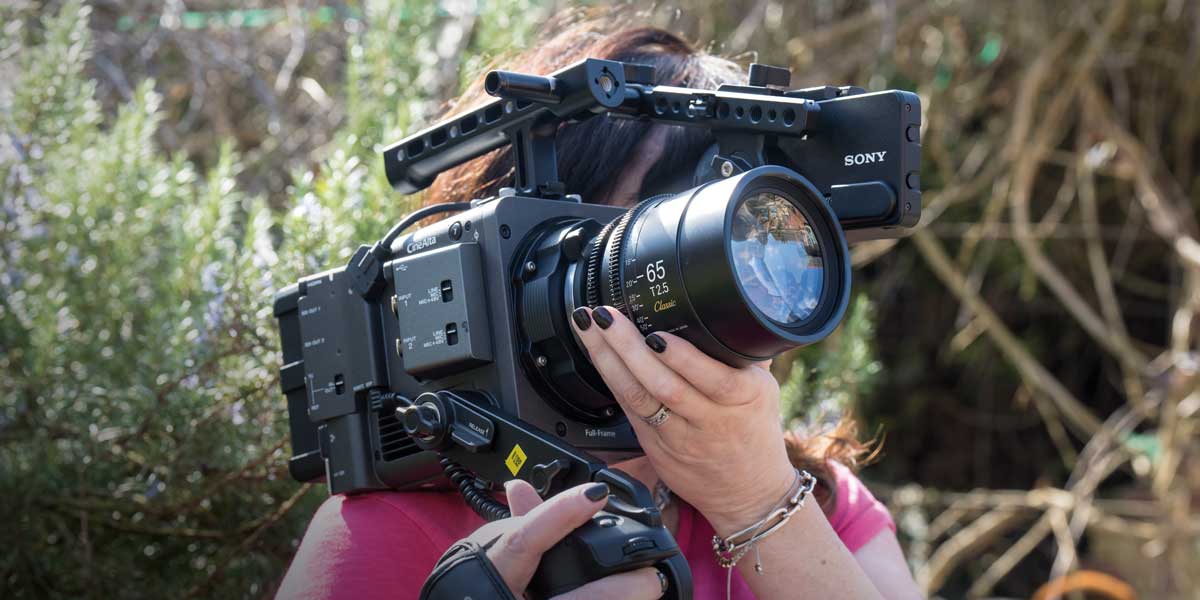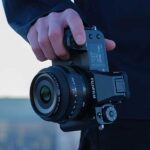
Sony Burano is a Must-Have
Posted on May 20, 2024 by Samara Husbands
Independence 8K
Sony’s Burano boasts image quality from the flagship Venice 2 with user-friendly features to make it ideal for indie production
If you love the run-and-gun capabilities of the Sony FX9 cinema camera – but yearn for even higher image quality that comes from 16-bit, 8K Raw files – Sony’s Burano is what you have been waiting for.
That’s if the heavyweight £32,350/$31,889 price tag for the kit we tested is not a major hurdle.
The Burano sits midway between the full-frame FX9 and the legendary Venice 2, a camera favoured by many Hollywood DOPs for big-budget blockbusters due to its stunning quality and flexibility.
Where the no-compromise Venice 2 is built for sizeable crews to rig up and operate, the Burano can function as a single-shooter documentary camera used on the shoulder – since it boasts excellent phase detection autofocus.
And it’s the first camera of this type to offer built-in image stabilisation for all lenses, including PL-fit manual optics as well as its own native Sony E-mount glass.
It’s smaller, lighter and significantly cheaper than the 8K Venice 2. Currently, that costs around £67,000/$58,000 for body only.
That’s the steep price of entry to this elevated world of incredible files with oodles of dynamic range and colour information that can be graded to the maximum.
The Burano has the same 8.6K sensor at its heart, but omits the two most high-end Raw codecs of the Venice 2.
After all, something has to go to make a camera that costs so much less. Build quality isn’t quite the same either, although it is still built like a tank and will take more abuse than any lesser camera.
The Burano offers 16-bit 8632×4856 files in lots of frame rates and crops in the X-OCN LT format. This is a slightly more compressed version of the Sony Raw format from the Venice 2.
That also offers X-OCN in the more detailed ST and XD flavours for even more colours and a corresponding increase in files sizes.
If you must have the absolute ultimate quality, then the 16-bit Raw XD in the Venice 2 is it. But the 8.6K Raw in the Burano is still full of information – and simply incredible at half the price in a more usable package.
Let’s face it, the only reason to spend more than double the price of an FX9 is to access the high resolution, high bit depth and Raw quality of the Burano. Except it’s not as simple as the camera offering every frame rate and crop in every resolution and codec. It’s far more complicated.
If you want to shoot 8.6K in 16:9 or 17:9 full-frame, you’re stuck at a maximum of 30fps whether you shoot in X-OCN Raw or XAVC. All the XAVC files are 4:2:2 10-bit H.265, with the H-L setting shooting at 520Mbps, the H-I SQ at 800Mbps and the H-I HQ at 1200Mbps.
H-L is not available if shooting in 8K, though.
If you want to go to 60fps, there is a much bigger choice, although all have some sort of crop.
If shooting X-OCN, you can set 6K in 16:9 or 17:9 which is a slight crop that oversamples the 8K footage down to 6K.
There’s no line-skipping or pixel-binning on a camera like this that values quality. If you choose XAVC, this can be oversampled to C4K, 4K or HD.
Alternatively, a Super 35 mode uses a tighter crop of the sensor. Choose X-OCN and it’s in 5.8K, or XAVC where it can be C4K or HD.
To get anything faster, you have to set Super 35 crop in either Raw or XAVC, where you can shoot in 4K/120p. That’s great for action as it gives your lenses far more reach.
It gets even more complicated when you want to output the different signals via SDI or HDMI, include baked-in LUTs or set a de-squeeze option.
For example, record in 8.6K in X-OCN and the SDI outputs HD, but can’t output an HDMI signal at the same time.
Shoot 6K in XAVC-I, meanwhile, and the SDI and HDMI can output 4K or HD at the same time with or without LUTs – but not output any anamorphic de-squeeze unless it’s HD through the HDMI.
It’s a minefield of permutations, and Sony has set up a website so users can see what settings work. It makes sense to download this to a phone so you’ll always have it with you.
When shooting, you’ll find a choice of the usual Sony Cine EI and Custom modes, and you can adjust lots of parameters including noise suppression levels in three steps.
Base ISO settings are 800 and 3200 in S-Log3, and you can use internal LUTs or load your own. These can be baked in or not, as you wish.
The camera records in H.265, which is roughly twice as quick as H.264 but needs a fast computer to run, or else you’ll be in a world of proxies and hours of rendering. And with massive file size, you’ll need huge, fast hard drives to store the footage as well as pricey CFexpress Type B cards in the twin slots.
We used a pair of 1920GB Sony cards, which are VPG400 rated though cost £2058/$1998 each.
You could choose cheaper cards, but do need VPG400 spec to let the camera record without issues. Sony’s cards come with free recovery service, so if there are any issues they should be sorted for free.
When it comes time to edit, the files are stored in an MXF wrapper like the Venice 2.
If you are shooting X-OCN Raw, each clip is stored in its own folder, so opening them in DaVinci Resolve is quite a pain. XAVC files open in all NLEs, except you can’t control settings as well as you can with pure Raw files – or Camera Negatives as Sony likes to call them.
That’s where you get the real benefits. However, S-Cinetone gives a cinematic look straight out of camera. Using that on something like the Burano does seem like a bit of a waste.
The bottom line is that you need to understand what each codec offers, how to set the camera up correctly and how to process the files properly. This is not a camera for beginners.
All this work is the price you pay for simply stunning files. In all settings, all sizes – the camera produces rich colours and an incredible dynamic range of up to 16 stops.
The footage is simply incredible; you can pull and push it around in the grade as much as you like. It’s forgiving of over and underexposure, too.
In terms of colour, some early users reported that there can be issues when shooting things like black fabrics due to IR pollution – especially when dialling in the internal ND filters.
We had no issues, but to be safe it’s best to do a custom white-balance when shooting XAVC. In Raw, there are no issues as white-balance can be accurately altered in post.
The only minor niggle with the footage is that, as the camera doesn’t have a global shutter and doesn’t read out its sensor signal quite as fast as the Venice 2, you can get minor rolling shutter effects. But this is only in fast whip pans.
For creative effects, the camera offers slow shutter speeds down to 64F, which is 2.5 secs at 25p, and can drop to as low as 1fps if you like. So time-lapse shots are a breeze.
The camera itself is solidly built and has lots of customisable buttons, though there is no power output socket to provide juice for accessories.
You would need to use a V-Lock battery with a D-Tap socket for that.
There is also no mic mount included, so you have to rig one up for yourself.
An alternative is that the camera has the same contacts and top mounts as the FX9, so you could buy an FX9 top handle and fit that.
This version has the MI Shoe, so you could push on one of Sony’s wireless receivers with no need for any extra cables.
The camera itself offers two XLR audio inputs as well as four-channel audio recording with good-quality preamps.
Our biggest gripe is with the three-inch touchscreen and loupe that turns it into an EVF, ideal for shoulder use.
The screen is decent quality and has good buttons around it for adjustments.
But to work with the loupe, you have to mount the screen on the top handle pointing sideways.
So if you want to change to a tripod and use the screen for monitoring, you have to slide off the loupe then take the screen off and re-fix it after turning it through 90°.
It only takes a few seconds, but when you’re on a shoot it feels like a total faff.
Several aftermarket companies have already come up with solutions ranging from a whole new screen and EVF combo to swivel mounts, brackets and more.
It’s a shame Sony didn’t do a better job, as the actual screen and the way it displays shooting info around the edges of the frame is very good.
You can also change settings on the touchscreen. Or you can hit the menu button – or push it in for a few seconds to open an expanded menu and use the mini joysticks.
Sony’s menus often come in for criticism, but this one is about the best of the bunch. To review your shots, push the Clips button on the side, as you’d imagine.
One foible is that it will only let you see and play back clips that have been shot in the same codec as the camera is currently set to.
This is not perfect, and rebooting after codec changes takes a few seconds each time.
Not bad for a heavyweight cinema camera, but still a pain. Booting the camera up also takes a couple of seconds, which is very quick.
One good accessory with the camera is the side handle remote control, which bolts on using a standard rosette and makes the camera decent for on-the-shoulder use.
But you will likely need some sort of shoulder pad, as it’s not especially comfortable without one – especially for a boxy, heavy camera-and-lens combination.
The Burano comes with a Sony E-mount on the front with a solid lever-lock to fasten on lenses.
But this is actually hidden behind a lever-lock PL mount that uses six captured hex-head bolts to cover the E-mount.
So you have full PL and E-mount capability, changeable in a minute or so. Both pass through metadata, too, as long as compatible lenses are fitted.
Using native Sony AF glass unlocks the phase detection system.
This will be a revelation to anyone that hasn’t encountered it before. It’s fast, predictable and sticks to subjects well.
The transition and speed of operation can be adjusted in the menus, too, as well as human body and face detection. You can even tap the screen to set focus points.
So having PL and E mounts gives the best of both worlds – the latest AF or tactile, old-school MF.
A first for a camera like this is the inclusion of in-body image stabilisation.
Used with a Sony AF lens, this is a five-axis system and works very well. When used with a PL or other manual lens, it is a three-axis system that also does a fair job.
Given that this camera is targeted at indie production, this is a real bonus as you don’t have to be using a gimbal or tripod all the time.
In yet another nod to the latest tech, the camera can also be set to have a prerecord function of between three and 15 seconds, depending on the codec.
This is ideal for wildlife shooters who know that they have captured something before they press down on the nice, illuminated red record button.
The Burano also offers focus breathing compensation and there are lots of monitoring tools like zebras, waveforms and histograms. But there is no false colour monitoring, although you can upload a false colour LUT and deploy that.
If you know what you’re doing, there are ways to set this camera up to accomplish just about anything, with no compromises. It’s like a mini Venice at half the price.
This was first published in the May/June 2024 issue of Pro Moviemaker.










